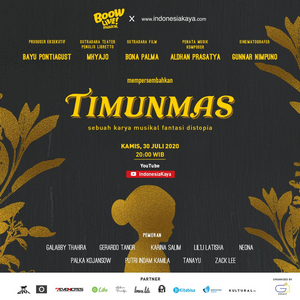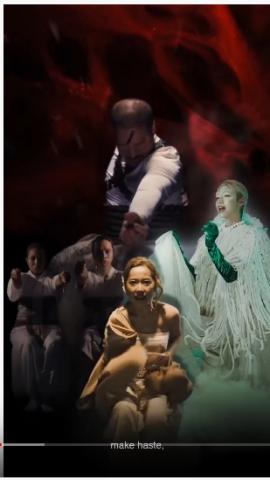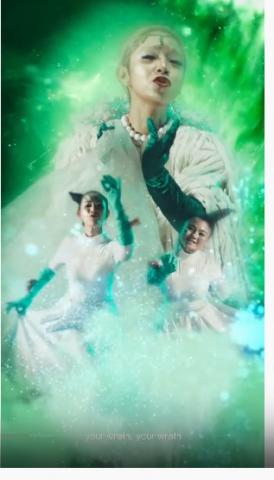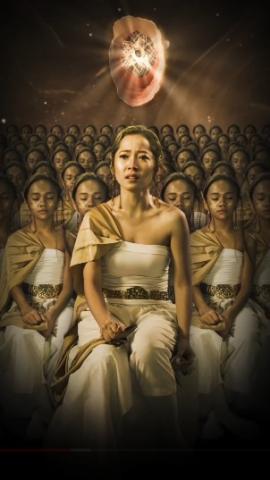Review: #MusikalDiRumahAja Dystopian Rendition TIMUN MAS is an Enchanting Chaos
The second episode of #MusikalDiRumahAja web musical series, Timun Mas, brought the children's tale into a new, surreal realm.
 The second episode of #MusikalDiRumahAja web musical series, Timun Mas, brought the children's tale into a new, surreal realm. It puts its meticulously stylistic presentation up and front, at the cost of muddling its substance behind a veneer of colors and light.
The second episode of #MusikalDiRumahAja web musical series, Timun Mas, brought the children's tale into a new, surreal realm. It puts its meticulously stylistic presentation up and front, at the cost of muddling its substance behind a veneer of colors and light.
Timun Mas was available to watch at Indonesiakaya.com's YouTube channel, the result of a joint project between them and BOOW! Live. The episode was penned by prolific creative conceptor Mhyajo, who also assumed the role of theatrical director and librettist. She worked in collaboration with award-winning cinematic director Bona Palmo and composer Aldhan Prasaya.
This adaptation of Timun Mas transplanted the story to a post-apocalyptic setting, where women could no longer bear their own children. Mbok Srini (Galabby Thahira) made a deal with Raksasa Dunia (Zack Lee) to obtain a child who would have to be returned eventually. The offspring came in the form of a golden cucumber with a serial number on it that soon opened to reveal Timun Mas (Neona).

After 17 years, Timun Mas grew up to become a young woman (Karina Salim). Although Srini had previously managed to convince Raksasa's goons (Gerardo Tanor and Palka Kojansow) to postpone the collection, this time the Raksasa Dunia himself came to take Timun back. Srini asked for Ratu Peri Hutan's (Tanayu) help. She and her two attendants (Lil'li Latisha and Putri Indam Kamila) aided Timun Mas by giving her four pouches containing magical condiments.
Timun Mas made her escape from Raksasa Dunia, pelting him with the contents of the pouches, which obstructed him. Although she was safe in the end, she broke into tears when she found herself among other little Timun Mas, a reminder of the dystopian world she lived in.
Even from the very first frame, it was apparent that the showmakers had crafted a unique, surrealist sense of identity for Timun Mas to set it apart from other episodes, or even other web musicals. The musical was shot in portrait mode, despite conventional wisdom promoting landscape orientation to fit better on computer screens.

The show made very heavy use of CGI backgrounds of a barren planet with vaguely futuristic buildings. Characters, signs, and set pieces flew in and out of frame, painting a picture of the setting's lore. The effect was jarring at first, akin to an arcade video game, and that uncanniness lingered throughout the runtime.
However, that very uncanniness might very well be what the directors intended. The experience of watching Timun Mas was a highly elevated one.

Another stand out aspect was the fact that every character's movement range was limited by them having to stay seated on a chair. Right before the episode ended, it explained that the chairs were metaphorical of the characters' diminished independence in the oppressive society. A novel idea, although outright including an explanation was perhaps quite the blunt solution to convey the meaning.
Although its appeal might be subjective, there was no denying that this rendition of Timun Mas was a visual punch. Even beyond the graphics, the costumes, make up, the physical props, editing, and the way the actors moved all worked harmoniously in creating a thoroughly memorable visual experience with many haunting frames.
However, the setting and story were perhaps too ambitious for the format. Explicitly emblazoning the label of post-apocalypse brought with it a certain set of expectations; the work did not delve into its post-apocalyptic settings and felt unnecessary, especially due to the more fantastical elements (fairies) and general production design, which drew more from general sci-fi and high fantasy.

Meanwhile, although the setting got a drastic make-over, the story itself did not; the creators' vision on Timun Mas had promise, raising the issues of synthetic human beings (explaining her being born from a cucumber plant) and their right to self-determination.
However, perhaps in part owing to its limited length, these questions were not solved but made way to new ones (for example, if Raksasa Dunia was such an all-powerful entity with seemingly a whole group of corporate drones working under him, why did he let Srini extend the agreement without repercussions?).
The adaptation was also a good chance to perhaps slightly shed light on why Srini was entitled to keep Timun Mas, or even for Timun herself to be independent, if the script had elaborated on it. Rather, Srini breaking a contract she signed out of her free will and Timun taking down the Raksasa Dunia felt unearned and hard to justify.
Furthermore, by adding fantastical, deus-ex-machina elements such as the Ratu Peri Hutan (literally translating into Fairy Queen of the Forest), the audience can easily be lost among the many, often contradicting, elements. As the presentation and setting were already bombastic on their own, a more concise, focused story would have helped to make the experience not so overwhelming.
For their part, the actors did a great job. Everyone seemed comfortable and confident in their roles. The climactic emotional moment was Timun Emas' cry of both relief and anguish near the end, expressed with the right mix of subtlety and expressiveness by Karina Salim.
Timun Mas was crafted as a sung-through musical with barely any spoken lines. The music was perfunctory, working smoothly in tandem with the dreamlike atmosphere but never quite standing out. The actors sang their parts quite well, but none of them get to show off the full extent of their capability.
Taken altogether, Timun Mas was an ambitious project dripping with unabashed style. It had the makings of a project born out of passion, with all its high points and pitfalls; it was more of an art expression than a typical musical, and best experienced as such. There is no denying Timun Mas left a lasting impression, and that is more than other creative works could achieve nowadays.

Image credits: Image Dynamics, BOOW! Live and Indonesiakaya.com.
Reader Reviews

Videos


